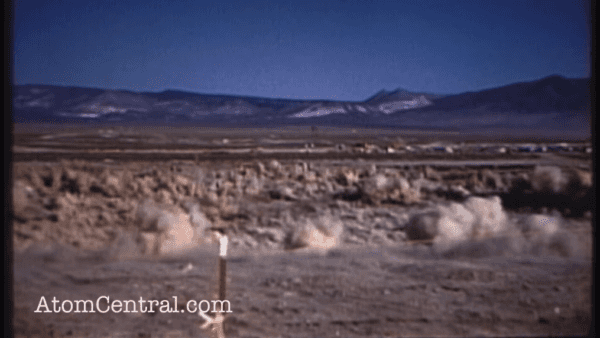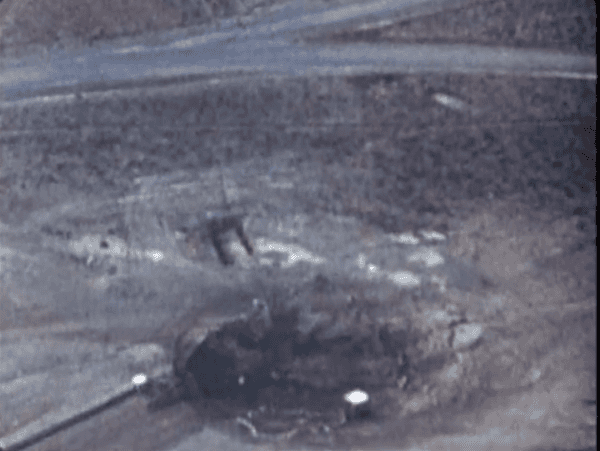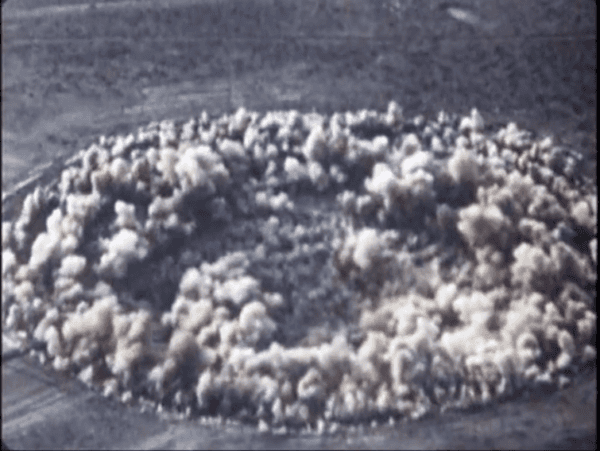There is little more apocalyptic than watching a video of a nuclear test. Underground nuclear tests are in another category of eeriness.
The first sign is the ground caving in on itself in a perfectly circular pattern. Then a shockwave in the same circular imprint sends plumes of dirt shooting back upward.

Subsidence Crater Formation. (atomcentral/YouTube)
Check out the nuclear crater in action:
As noted by the Arms Control Association, more than 2,000 nuclear test explosions have occurred since 1945, carried out by at least eight countries.
Between 1946-1962, 193 atmospheric tests were carried out by the U.S. largely in the Pacific and Nevada.
These tests affected “over 200,000 military and civilian personnel of which, 2,000-3,000 military personnel were part of government-sponsored medical research,” the Arms Control Association said.
Between 1949-1962, Russia had conducted 142 atmospheric nuclear tests.

Subsidence Crater Formation. (MyEarbot/YouTube)
Nuclear testing amplified, and by 1952, the United Kingdom conducted their first nuclear test in Western Australia.
The U.S. tested the first hydrogen bomb on Nov. 1952, which annihilated Elugelab Island in the Marshall chain in the Pacific.
After the U.S. and Russia carried out separate testing in 1954, radioactive fallout became a primary concern after tests contaminated the Marshall Islands and members of the Japanese Lucky Dragon fishing boat were poisoned by radiation.
It was Russia that suggested a “nuclear test ban as the initial step toward nuclear disarmament,” in 1954, as per the Arms Control Association.
President Eisenhower advised a test freeze for a period of one year as long as the Soviets also abstained from testing. This agreement, known as the beginning of U.S.-UK-USSR test ban negotiations, started in Oct. 1958.
After further negotiations between the U.S. and Russia failed, both resumed testing and on a bigger scale, not to be outdone.
Russia pulled off the biggest nuclear test explosion in history in Oct. 1961. However, the following year, the Cuban Missile Crisis brought Russia and the U.S. to a near nuclear war.
President John F. Kennedy and Soviet Premier Nikita Krushchev began working on a resolve in 1962.
According to the JFK Library, the U.S., Russia, and Great Britain signed the Limited Nuclear Test Ban Treaty on Aug. 5, 1963. This treaty put a ban on certain nuclear weapons testing, including those in the air, space, or underwater.
The purpose was to put “an end to the contamination of man’s environment by radioactive substances,” and became law on Oct. 10, 1963, the JFK Library stated.

Subsidence Crater Formation. (MyEarbot/YouTube)
The Limited Test Ban Treaty was the first of several treaties that would follow through the Cold War, according to the U.S. Dept of State. The Non-Proliferation Treaty that was signed in 1968, then the SALT I agreements in 1972, and the Threshold Test Ban Treaty in 1974. The latter of the three restricted underground tests of nuclear bombs larger than 150 kilotons.
Even underground nuclear tests still pose the risk of contaminating the land and water, but the monitoring of nearby environmental conditions keeps things in check, eliminating most threats, according to Atlas Obscura.



